NCERT Solutions for Exercise 9.4 Class 9 Maths Chapter 9 - Areas Of Parallelograms And Triangles
The NCERT Solutions for Class 9 Maths exercise 9.4 is an optional (not from the examination point of view) exercise which comprises of theorems related to the previous exercises which include concepts of parallelograms and triangle on the same base and between the same parallels, having questions related to areas of figure which includes the medians for triangles.
This Story also Contains
- Areas Of Parallelograms And Triangles Class 9 Chapter 9 Exercise: 9.1
- More About NCERT Solutions for Class 9 Maths Exercise 9.4
- Benefits of NCERT Solutions for Class 9 Maths Exercise 9.4
- NCERT Solutions of Class 10 Subject Wise
- Subject Wise NCERT Exemplar Solutions
Few important concepts related to NCERT syllabus Class 9 Maths chapter 9 exercise 9.4 in order to solve this exercise are:
Parallelograms having the same base and are in between the same parallels have the same area, as because the height (distance between the two parallel lines) continues as before for the two parallelograms and they have same bases subsequently their regions are equivalent.
Triangle that has a same base or the equivalent base and are between same pair of parallel lines have equivalent area. This is on the grounds that we realize that the area of the triangle is a half of the result of base and height. Since the height (distance between the parallels) continues as before for the two triangles and they have same bases subsequently their area are equivalent.
Major questions in this exercise use a blend of at least two or more concepts.
Along with NCERT book Class 9 Maths chapter 9 exercise 9.4 the following exercises are also present.
Areas Of Parallelograms And Triangles Class 9 Chapter 9 Exercise: 9.1
Answer:
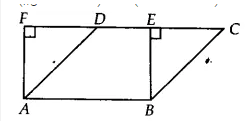
![]()
We have ||gm ABCD and a rectangle ABEF both lie on the same base AB such that, ar(||gm ABCD) = ar(ABEF)
for rectangle, AB = EF
and for ||gm AB = CD
$\Rightarrow$ CD = EF
$\Rightarrow$ AB + CD = AB + EF ...........(i)
SInce $\Delta$ BEC and $\Delta$ AFD are right angled triangle
Therefore, AD > AF and BC > BE
$\Rightarrow$ (BC + AD ) > (AF + BE)...........(ii)
Adding equation (i) and (ii), we get
(AB + CD)+(BC + AD) > (AB + BE) + (AF + BE)
$\Rightarrow$ (AB + BC + CD + DA) > (AB + BE + EF + FA)
Hence proved, perimeter of ||gm ABCD is greater than perimeter of rectangle ABEF.
 Answer:
Answer:
In $\Delta$ ABC, D and E are two points on BC such that BD = DE = EC
AD is the median of ABE, therefore,
area of ABD= area of AED...................(1)
AE is the median of ACD, therefore,
area of AEC= area of AED...................(2)
From (1) and (2)
area of ABD=area of AED= area of AEC
Hence proved.
Q3 In Fig. $\small 9.31$ , ABCD, DCFE and ABFE are parallelograms. Show that $\small ar(ADE)=ar(BCF)$ .
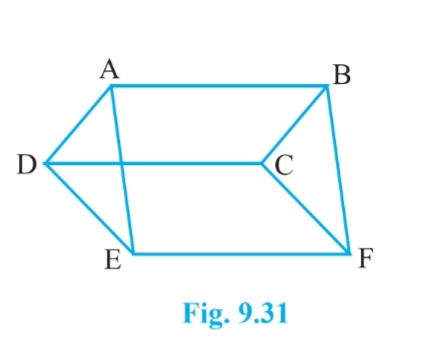 Answer:
Answer:
Given, 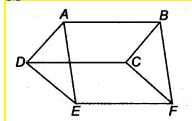
![]()
ABCD is a parallelogram. Therefore, AB = CD & AD = BC & AB || CD .......(i)
Now, $\Delta$ ADE and $\Delta$ BCF are on the same base AD = BC and between same parallels AB and EF.
Therefore, ar ( $\Delta$ ADE) = ar( $\Delta$ BCF)
Hence proved.
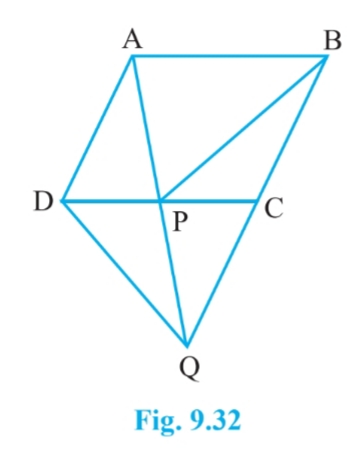 Answer:
Answer:
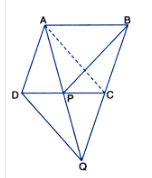
![]()
Given,
ABCD is a ||gm and AD = CQ. Join AC.
Since $\Delta$ DQC and $\Delta$ ACD lie on the same base QC and between same parallels AD and QC.
Therefore, ar( $\Delta$ DQC) = ar( $\Delta$ ACD).......(i)
Subtracting ar( $\Delta$ PQC) from both sides in eq (i), we get
ar( $\Delta$ DPQ) = ar( $\Delta$ PAC).............(i)
Since $\Delta$ PAC and $\Delta$ PBC are on the same base PC and between same parallel PC and AB.
Therefore, ar( $\Delta$ PAC) = ar( $\Delta$ PBC)..............(iii)
From equation (ii) and eq (ii), we get
$\small ar (BPC) = ar (DPQ)$
Hence proved.
$\small ar(BDE)=\frac{1}{4}ar(ABC)$
[ Hint: Join EC and AD. Show that $\small BE\parallel AC$ and $\small DE\parallel AB$ , etc.]
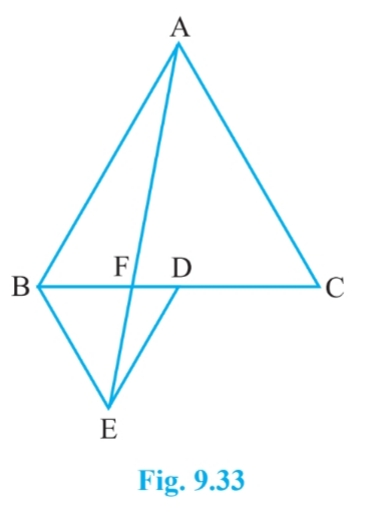 Answer:
Answer:

![]()
Let join the CE and AD and draw $EP \perp BC$ . It is given that $\Delta$ ABC and $\Delta$ BDE is an equilateral triangle.
So, AB =BC = CA = $a$ and D i sthe midpoint of BC
therefore, $BD = \frac{a}{2}= DE = BE$
(i) Area of $\Delta$ ABC = $\frac{\sqrt{3}}{4}a^2$ and
Area of $\Delta$ BDE = $\frac{\sqrt{3}}{4}(\frac{a}{2})^2= \frac{\sqrt{3}}{16}a^2$
Hence, $\small ar(BDE)=\frac{1}{4}ar(ABC)$
[ Hint: Join EC and AD. Show that $\small BE\parallel AC$ and $\small DE\parallel AB$ , etc.]
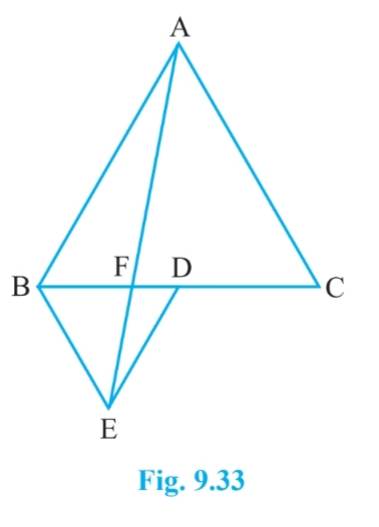
Answer:
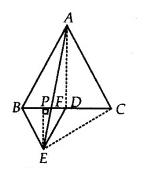
![]()
Since $\Delta$ ABC and $\Delta$ BDE are equilateral triangles.
Therefore, $\angle$ ACB = $\angle$ DBE = $60^0$
$\Rightarrow$ BE || AC
$\Delta$ BAE and $\Delta$ BEC are on the same base BE and between same parallels BE and AC.
Therefore, ar ( $\Delta$ BAE) = ar( $\Delta$ BEC)
$\Rightarrow$ ar( $\Delta$ BAE) = 2 ar( $\Delta$ BED) [since D is the meian of $\Delta$ BEC ]
$\Rightarrow$ $\small ar(BDE)=\frac{1}{2}ar(BAE)$
Hence proved.
[ Hint : Join EC and AD. Show that $\small BE\parallel AC$ and $\small DE\parallel AB$ , etc.]
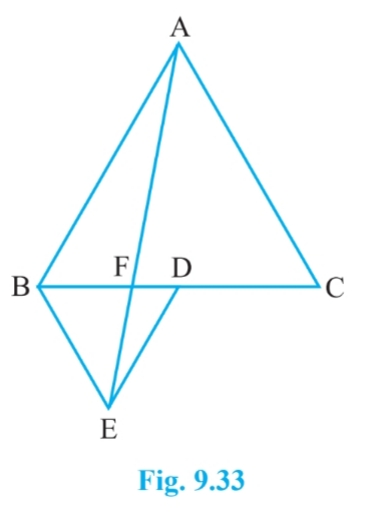
Answer:
We already proved that,
ar( $\Delta$ ABC) = 4.ar( $\Delta$ BDE) (in part 1)
and, ar( $\Delta$ BEC) = 2. ar( $\Delta$ BDE) (in part ii )
$\Rightarrow$ ar( $\Delta$ ABC) = 2. ar( $\Delta$ BEC)
Hence proved.
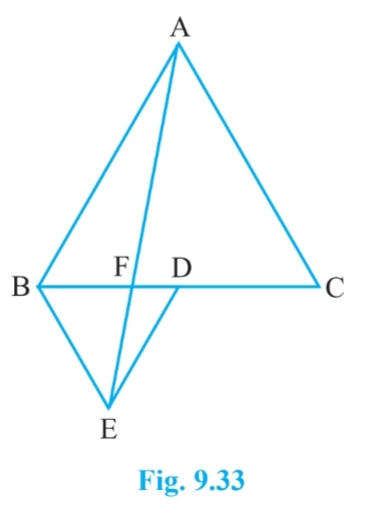
Answer:
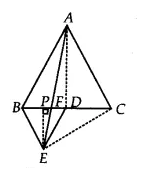
![]()
Since $\Delta$ ABC and $\Delta$ BDE are equilateral triangles.
Therefore, $\angle$ ACB = $\angle$ DBE = $60^0$
$\Rightarrow$ BE || AC
$\Delta$ BDE and $\Delta$ AED are on the same base ED and between same parallels AB and DE.
Therefore, ar( $\Delta$ BED) = ar( $\Delta$ AED)
On subtracting $\Delta$ EFD from both sides we get
$\small ar(BFE)=ar(AFD)$
Hence proved.
[ Hint : Join EC and AD. Show that $\small BE\parallel AC$ and $\small DE\parallel AB$ , etc.]
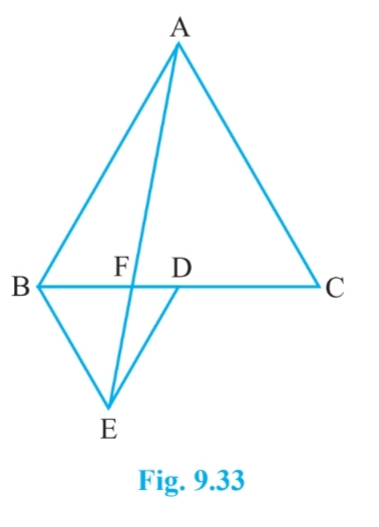
Answer:

![]()
In right angled triangle $\Delta$ ABD, we get
$\\AB^2 = AD^2+BD^2\\ AD^2 = AB^2-BD^2$
$=a^2 - \frac{a^2}{4}=\frac{3a^2}{4}$
$AD=\frac{\sqrt{3}a}{2}$
So, in $\Delta$ PED,
$PE^2 = DE^2-DP^2$
$\\=(\frac{a}{2})^2-(\frac{a}{4})^2\\ =\frac{3a^2}{16}$
So, $PE=\frac{\sqrt{3}a}{4}$
Therefore, the Area of $\Delta AFD =1/2 (FD)\frac{\sqrt{3}a}{2}$ ..........(i)
And, Area of triangle $\Delta EFD =1/2 (FD)\frac{\sqrt{3}a}{4}$ ...........(ii)
From eq (i) and eq (ii), we get
ar( $\Delta$ AFD) = 2. ar( $\Delta$ EFD)
Since ar( $\Delta$ AFD) = ar( $\Delta$ BEF)
$\Rightarrow$ $\small ar(BFE)=2ar(FED)$
[ Hint: Join EC and AD. Show that $BE\parallel AC$ and $DE\parallel AB$ , etc.]
 Answer:
Answer:
$ar(\Delta AFC) =$
$\\= ar(\Delta AFD) + ar(\Delta ADC)\\ = ar(\Delta BFE) + 1/2. ar(\Delta ABC)\\ = ar(\Delta BFE) + 1/2\times [4\times ar(\Delta BDE)]\\ = ar(\Delta BFE) + 2\times ar(\Delta BDE)$
$= 2\times ar (\Delta FED) + 2\times [ar(\Delta BFE) + ar(\Delta FED)]$ .....(from part (v) ar( $\Delta$ BFE) = 2. ar( $\Delta$ FED) ]
$\\=2ar(\Delta FED) + 2[3\times ar(\Delta FED)]\\ =8\times ar(\Delta FED)$
$ar (FED) = \frac{1}{8} ar (AFC)$
Hence proved.
[ Hint: From A and C, draw perpendiculars to BD.]
Answer:
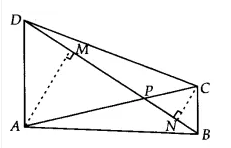
![]()
Given that,
A quadrilateral ABCD such that it's diagonal AC and BD intersect at P. Draw $AM \perp BD$ and $CN \perp BD$
Now, ar( $\Delta$ APB) = $\frac{1}{2}\times BP\times AM$ and,
$ar(\Delta CDP)=\frac{1}{2}\times DP\times CN$
Therefore, ar( $\Delta$ APB) $\times$ ar( $\Delta$ CDP)=
$\\=(\frac{1}{2}\times BP\times AM).(\frac{1}{2}\times DP \times CN)\\ =\frac{1}{4}\times BP \times DP\times AM\times CN$ ....................(i)
Similarly, ar( $\Delta$ APD) $\times$ ar ( $\Delta$ BPC) =
$=\frac{1}{4}\times BP \times DP\times AM\times CN$ ................(ii)
From eq (i) and eq (ii), we get
$ar (APB) \times ar (CPD) = ar (APD) \times ar (BPC).$
Hence proved.
$\small ar(PRQ)=\frac{1}{2}ar(ARC)$
Answer:
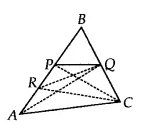
![]()
We have $\Delta$ ABC such that P, Q and R are the midpoints of the side AB, BC and AP respectively. Join PQ, QR, AQ, PC and RC as shown in the figure.
Now, in $\Delta$ APC,
Since R is the midpoint. So, RC is the median of the $\Delta$ APC
Therefore, ar( $\Delta$ ARC) = 1/2 . ar ( $\Delta$ APC)............(i)
Also, in $\Delta$ ABC, P is the midpoint. Thus CP is the median.
Therefore, ar( $\Delta$ APC) = 1/2. ar ( $\Delta$ ABC)............(ii)
Also, AQ is the median of $\Delta$ ABC
Therefore, 1/2. ar ( $\Delta$ ABC) = ar (ABQ)............(iii)
In $\Delta$ APQ, RQ is the median.
Therefore, ar ( $\Delta$ PRQ) = 1/2 .ar ( $\Delta$ APQ).............(iv)
In $\Delta$ ABQ, PQ is the median
Therefore, ar( $\Delta$ APQ) = 1/2. ar( $\Delta$ ABQ).........(v)
From eq (i),
$\frac{1}{2}ar(\Delta ARC)= \frac{1}{4}ar(\Delta APC)$ ...........(vi)
Now, put the value of ar( $\Delta$ APC) from eq (ii), we get
Taking RHS;
$= \frac{1}{8}[ar(\Delta ABC)]$
$= \frac{1}{4}[ar(\Delta ABQ)]$ (from equation (iii))
$= \frac{1}{2}[ar(\Delta APQ)]$ (from equation (v))
$=ar(\Delta PRQ)$ (from equation (iv))
$\Rightarrow$ $\small ar(PRQ)=\frac{1}{2}ar(ARC)$
Hence proved.
Answer:

![]()
In $\Delta$ RBC, RQ is the median
Therefore ar( $\Delta$ RQC) = ar( $\Delta$ RBQ)
= ar (PRQ) + ar (BPQ)
= 1/8 (ar $\Delta$ ABC) + ar( $\Delta$ BPQ) [from eq (vi) & eq (A) in part (i)]
= 1/8 (ar $\Delta$ ABC) + 1/2 (ar $\Delta$ PBC) [ since PQ is the median of $\Delta$ BPC]
= 1/8 (ar $\Delta$ ABC) + (1/2).(1/2)(ar $\Delta$ ABC) [CP is the medain of $\Delta$ ABC]
= 3/8 (ar $\Delta$ ABC)
Hence proved.
$ar (PBQ) = ar (ARC)$
Answer:
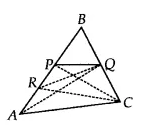
![]()
QP is the median of $\Delta$ ABQ
Therefore, ar( $\Delta$ PBQ) = 1/2. (ar $\Delta$ ABQ)
= (1/2). (1/2) (ar $\Delta$ ABC) [since AQ is the median of $\Delta$ ABC
= 1/4 (ar $\Delta$ ABC)
= ar ( $\Delta$ ARC) [from eq (A) of part (i)]
Hence proved.

Answer:
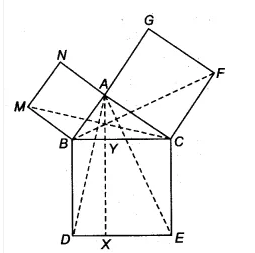
![]()
We have, a $\Delta$ ABC such that BCED, ACFG and ABMN are squares on its side BC, CA and AB respec. Line segment $\small AX\perp DE$ meets BC at Y
(i) $\angle CBD = \angle MBA$ [each 90]
Adding $\angle ABC$ on both sides, we get
$\angle ABC + \angle CBD = \angle MBA + \angle ABC$
$\Rightarrow \angle ABD = \angle MBC$
In $\Delta$ ABD and $\Delta$ MBC, we have
AB = MB
BD = BC
$\angle ABD = \angle MBC$
Therefore, By SAS congruency
$\Delta$ ABD $\cong$ $\Delta$ MBC
Hence proved.
Answer:

![]()
SInce ||gm BYXD and $\Delta$ ABD are on the same base BD and between same parallels BD and AX
Therefore, ar( $\Delta$ ABD) = 1/2. ar(||gm BYXD)..........(i)
But, $\Delta$ ABD $\cong$ $\Delta$ MBC (proved in 1st part)
Since congruent triangles have equal areas.
Therefore, By using equation (i) we get
$\small ar(BYXD)=2ar(MBC)$
Hence proved.
Answer:

![]()
Since, ar (||gm BYXD) = 2 .ar ( $\Delta$ MBC) ..........(i) [already proved in 2nd part]
and, ar (sq. ABMN) = 2. ar ( $\Delta$ MBC)............(ii)
[Since ABMN and AMBC are on the same base MB and between same parallels MB and NC]
From eq(i) and eq (ii), we get
$\small ar(BYXD)=ar(ABMN)$
Answer:
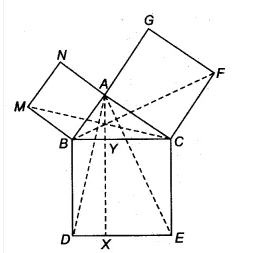
![]()
$\angle FCA = \angle BCE$ [both 90]
By adding $\angle$ ABC on both sides we get
$\angle$ ABC + $\angle$ FCA = $\angle$ ABC + $\angle$ BCE
$\angle$ FCB = $\angle$ ACE
In $\Delta$ FCB and $\Delta$ ACE
FC = AC [sides of square]
BC = AC [sides of square]
$\angle$ FCB = $\angle$ ACE
$\Rightarrow$$\Delta$ FCB $\cong$ $\Delta$ ACE
Hence proved.
Answer:
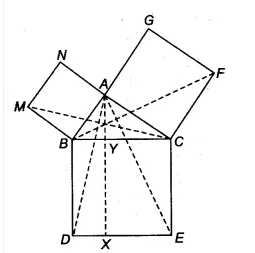
![]()
Since ||gm CYXE and $\Delta$ ACE lie on the same base CE and between the same parallels CE and AX.
Therefore, 2. ar( $\Delta$ ACE) = ar (||gm CYXE)
B ut, $\Delta$ FCB $\cong$ $\Delta$ ACE (in iv part)
Since the congruent triangle has equal areas. So,
$\small ar(CYXE)=2ar(FCB)$
Hence proved.
Answer:

![]()
Since ar( ||gm CYXE) = 2. ar( $\Delta$ ACE) {in part (v)}...................(i)
Also, $\Delta$ FCB and quadrilateral ACFG lie on the same base FC and between the same parallels FC and BG.
Therefore, ar (quad. ACFG) = 2.ar( $\Delta$ FCB ) ................(ii)
From eq (i) and eq (ii), we get
$\small ar(CYXE)=ar(ACFG)$
Hence proved.
Answer:

![]()
We have,
ar(quad. BCDE) = ar(quad, CYXE) + ar(quad. BYXD)
= ar(quad, CYXE) + ar (quad. ABMN) [already proved in part (iii)]
Thus, $\small ar(BCED)=ar(ABMN)+ar(ACFG)$
Hence proved.
More About NCERT Solutions for Class 9 Maths Exercise 9.4
NCERT solutions Class 9 Maths exercise 9.4 includes some important concepts from the previous exercises that may prove to be crucial in order to solve some miscellanies problems from NCERT solutions Class 9 Maths exercise 9.4 we get to know another idea which manages the opposite of the above theorem. We get to realize that in case two triangles or parallelograms have a similar base (or on the other hand in case they have an equivalent base) and in case they have the equivalent area then they lie on the same parallel line.
Apart from all the above-mentioned concepts, the vice versa of these concepts (theorem) are very critical in solving some questions.
Also Read| Areas Of Parallelograms And Triangles Class 9 Notes
Benefits of NCERT Solutions for Class 9 Maths Exercise 9.4
Exercise 9.4 Class 9 Maths, is based on AREAS OF PARALLELOGRAMS AND TRIANGLES and most of its crucial properties.
From Class 9 Maths chapter 9 exercise 9.4 we get to revise the entire concepts of this chapter in a single exercise.
Understanding the concepts from Class 9 Maths chapter 9 exercise 9.4 will make the concepts and questions from higher standards (like Class10) easier for us.
Also, See
NCERT Solutions of Class 10 Subject Wise
Subject Wise NCERT Exemplar Solutions
Courses After 12th
Applications for Admissions are open.
As per latest syllabus. Physics formulas, equations, & laws of class 11 & 12th chapters
JEE Main Important Chemistry formulas
Get nowAs per latest syllabus. Chemistry formulas, equations, & laws of class 11 & 12th chapters
JEE Main high scoring chapters and topics
Get nowAs per latest 2024 syllabus. Study 40% syllabus and score upto 100% marks in JEE
JEE Main Important Mathematics Formulas
Get nowAs per latest syllabus. Maths formulas, equations, & theorems of class 11 & 12th chapters
